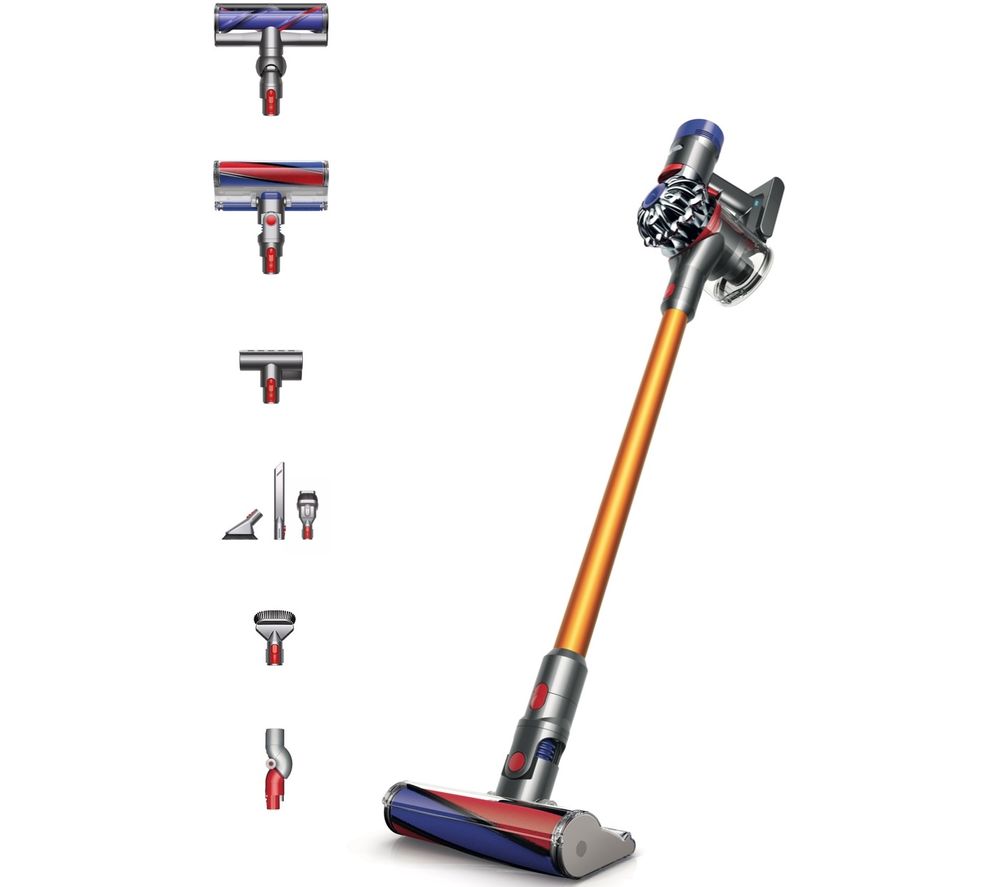Dyson V8 Animal Vacuum Cleaner
The Dyson V8 Animal stick vacuum is engineered for homes with pets. Captures dust, animal hair and allergens.
Powered by the Dyson digital motor V8
Spins at up to 110,000rpm to create powerful suction.
Up to 40 minutes of fade-free power*
Powerful suction for whole-home cleaning. Up to 40 minutes in Powerful mode and up to 25 minutes with motorized cleaner head.
*Actual run time will vary based on power mode and/or attachments used.
Two power modes
Switch between MAX mode for up to 7 minutes of high power, and Powerful mode for longer cleaning.
Whole machine filtration
The Dyson V8 Animal vacuum captures allergens and expels cleaner air than the air you breathe.
Combination tool
Two tools in one, for simple switching between surfaces.
Crevice tool
Designed for precise cleaning around edges and narrow gaps.
Mini motorized tool
Motorized brush bar tackles animal hair and ground-in dirt, in tight spaces.
Easily reaches up high
Lightweight and ergonomic to clean high-up places with one smooth motion.
Quickly transforms to a handheld
The Dyson V8™ changes to a handheld vacuum and back again, in just one click.
No-touch bin emptying
No need to touch the dirt – just push the button to release it.
2 Tier RadialTM cyclones
15 small cyclones create strong centrifugal forces, to capture microscopic dirt.
Docking station
Stores and recharges your Dyson V8™ vacuum, so it’s always ready for use.
Certified asthma & allergy friendly®
Traps allergens inside the machine, instead of expelling them back into the home.
Additional information
| Weight | 5.63 lb |
|---|---|
| Charge time | 5 hrs |
| Run time | Up to 40* min |
| Suction power (MAX mode) | 115 AW |
| Height | 9.8 in |
| Length | 49 in |
| Width | 8.8 in |






by Eric
Loved the ease of use and the weight of this Dyson. Very convenient to use in small areas like steps and furniture that is tufted. Love the attachments that enable further use of this great machine.
by Steve
We are Dyson addicts and this model maintains the expected quality. Excellent suction on all floor types.
by Cathy
I’m so happy with this vacuum!! I used one at a friends just for a light vacuum of crumbs and decided to purchase one for myself. I had no idea how much I would love this machine!!! It is powerful, convenient, easy to clean, fun and does a great job on my wood floors, carpet and area rugs. I use it everyday!!! Simple Awesome!!!
by Dave
Just got a Dyson, I thought they were a little pricey compared to others but 83% positive reviews won me over. This little compact machine is truly an animal on dirt and dust.
by Rotten
skeptical because of the price…worth every penny and more. thank you dyson!!!!
by Danu
have been an Oreck for years, easy and powerful, Yearly maintenance was cost effective completed by me.
When my wife showed me this vacuum, i did not want anything to do with it.
After some reservations, we bought one. I am here to tell you, I’m impressed.
We are both over 65. No more tripping over the cord.